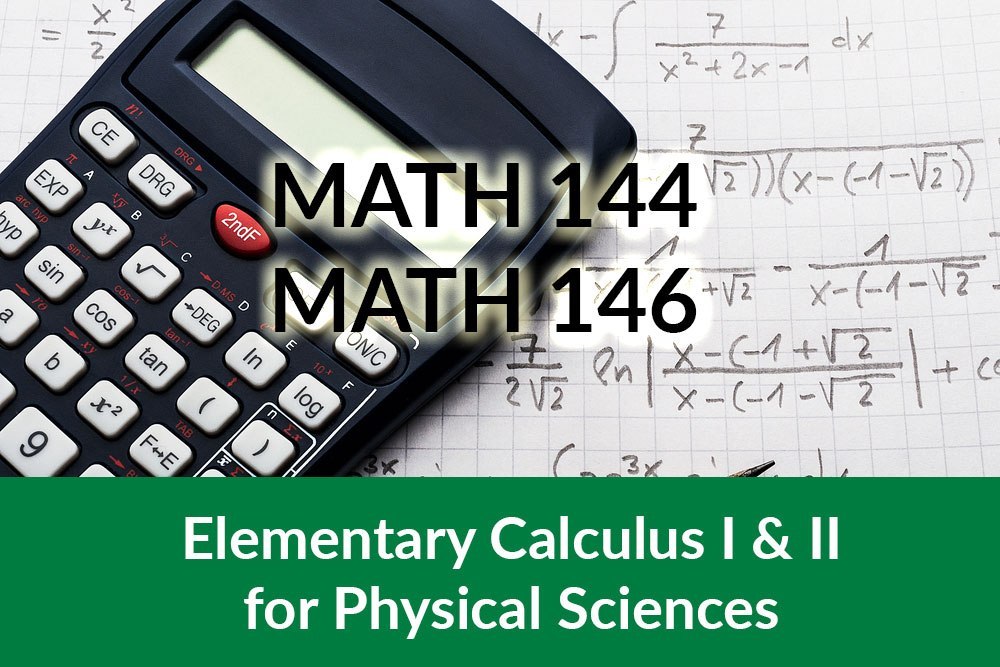Math 144 and 146

MATH 144 (Elementary Calculus I for Physical Sciences) and MATH 146 (Elementary Calculus II for Physical Sciences) are two courses that compose the introductory calculus sequence for Physical Sciences to increase relevancy and student motivation with a discipline-specific approach.
The rationale for transforming this course into a blended format was to improve student experience with more opportunities in class for individual and collaborative problem solving. The overall blended learning approach was to present new concepts and example problems through video format instead of lecture format. Transforming some of the current teacher-centered lectures into an online video format enabled in-class learner-centered interactive activities to support students in their assimilation of course content.
- Vincent Bouchard, Associate Professor, Department of Mathematical and Statistical Sciences.
- Gerda de Vries, Professor and Associate Chair (Undergraduate), Department of Mathematical and Statistical Sciences.
This course followed a Monday/Wednesday/Friday course structure. The online topic/task for this week was Integrals (Antiderivatives and Indefinite Integrals; Area Displacement and Riemann Sums; Definite Integrals). All student activities and resources were available on eClass.
Pre-class work during this week was due the evening before the Monday and Wednesday classes. However, on a regular week students would have pre-class work before the Monday, Wednesday, and Friday classes. Prior to this Monday’s class, students viewed a video entitled “Antiderivatives and Indefinite Integrals”. Prior to Wednesday’s class, students viewed a video entitled “Riemann Sums” and completed another short online quiz. Students also completed a short online quiz on WebAssign after each of the videos. The online quizzes contributed to the students’ final grade. During this week, students would also prepare for the in-class quiz on Friday. Learning objectives and lecture summary documents were posted on eClass.
- Lecture 19 Learning Outcomes
- Antiderivatives and Indefinite Integrals Video
- Lecture 19 Summary Sheet
- Lecture 20 Learning Outcomes
- Riemann Sums Video
- Lecture 20 Summary Sheet
Because students engaged with online elements prior to coming to class, in-class was used to engage with the topics in meaningful ways, such as working with a team to solve a problem. The lecture material from the videos was not repeated. In-class problem solving on Monday and Wednesday used Socrative. Friday was an in-class quiz (one of four quizzes that replaced the usual midterm exam) that used a two-stage format (stage one – write exam individually for 30 minutes; stage two – rewrite the quiz for 20 minutes in a group setting).
Post-class, students could revisit in-class material on eClass. Students also completed an online assignment on WebAssign, and a written assignment on CrowdMark about the material seen the week before. Both were due on Tuesday at 11:55 PM.
Roles of the content development team (~20 hours)
- Create the new materials and examples, and make the slides for the video with LaTeX.
- Annotate the slides with Squid, while streaming to a computer using Mirroring360 or Vysor, and record/edit a voice-over with Camtasia.
- Prepare the presentations for the in-class lectures with LaTeX.
- Plan different levels of difficulty for the Socrative questions to be able to respond to students’ performance.
- Formulate a practice quiz for students, and write the Friday in-class quiz.
- Prepare a summary sheets for each lecture.
- LaTeX document preparation system
- Squid note-taking app for Android
- Mirroring 360 wireless media streaming
- Vysor remote control desktop app
- Camtasia Studio screen recording and video editing
- Moodle learning management system
- WebAssign online instructional application
- Socrative audience response system
- iClicker audience response system
- V. Bouchard, “Blending and Flipping the First Year Calculus Sequence,” talk given at the Faculty of Science Celebration of Excellence, University of Alberta, May 2015.
- V. Bouchard, “Flipping and Blending the First Year Calculus Sequence,” talk given at the Alberta Mathematics Dialogue 2015, University of Lethbridge, May 2015.
- V. Bouchard, “Two-Stage Exams: Turning Exams Into Learning Opportunities,” talk given at the Assessment Symposium, Centre for Teaching and Learning, University of Alberta, August 2015.
- V. Bouchard and G. de Vries, “Tales from the Trenches: Blending and Flipping the First-Year Calculus Sequence at University of Alberta”, talk given at the Symposium on Scholarship of Teaching and Learning, Banff, November 2015.
- V. Bouchard, G. de Vries and M. Lewis, “Blending First-Year Calculus: Our Experience from MATH 134 (Calculus for the Life Sciences) and MATH 144 (Calculus for the Physical Sciences)”, talk given at the Blended Learning Showcase, University of Alberta, November 2016.
- V. Bouchard, G. de Vries and T. Hillen, “Blended Learning Workshop,” hands-on workshop on designing blended learning courses at the Alberta Mathematics Dialogue 2017, MacEwan University, May 2017.